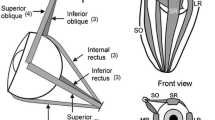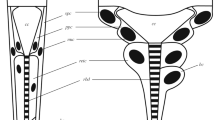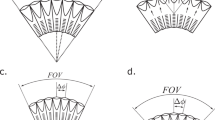Abstract
Several arthropods show by their behavior that they are able to measure the absolute distance or to gauge the absolute size of a nearby object, be it a prey, a mate or anything onto which the animal is going to jump (revs. Wehner 1981 ; Collett and Harkness 1982; Collett 1987).
Access this chapter
Tax calculation will be finalised at checkout
Purchases are for personal use only
Preview
Unable to display preview. Download preview PDF.
Similar content being viewed by others
References
Baldus K (1926) Experimentelle Untersuchungen über die Entfernungslokalisation der Libellen (Aeschna cyanea). Z Vergl Physiol 3:475–505.
Bauer T (1981) Prey capture and structure of the visual space of an insect that hunts by light on the litter layer (Notiophilus biguttatus F., Carabidae, Coleoptera). Behav Ecol Sociobiol 8:91–97.
Bauer T (1985a) Beetles which use a setal trap to hunt springtails: The hunting strategy and apparatus of Leistus (Coleóptera, Carabidae). Pedobiologia 28:275–287.
Bauer T (1985b) Different adaptation to visual hunting in three ground beetle species of the same genus. J Insect Physiol 31:593–603.
Bauers C (1953) Der Fixierbereich des Insektenauges. Z Vergl Physiol 34:589–605.
Bishop PO (1973) Neurophysiology of binocular single vision and stereopsis. In: Jung R (ed) Handbook of sensory physiology, vol VII/3A. Springer, Berlin Heidelberg New York, pp 255–305.
Burkhardt D, de la Motte I (1983) How stalk-eyed flies eye stalk-eyed flies: observations and measurements of the eyes of Cyrtodiopsis whitei (Diopsidae, Diptera). J Comp Physiol A 151:407–422.
Burkhardt D, de la Motte I (1985) Selective pressures, variability, and sexual dimorphism in stalk-eyed flies (Diopsidae). Naturwissenschaften 72:204–206.
Burkhardt D, Darnhofer-Demar B, Fischer K (1973) Zum binokularen Entfernungssehen der Insekten. I. Die Struktur des Sehraums von Synsekten. J Comp Physiol 87:165–188.
Clarkson ENK (1966) Schizochroal eyes and vision in some phacopid trilobites. Palaeontology 9:464–487.
Clarkson ENK, Levi-Setti R (1975) Trilobite eyes and the optics of Descartes and Huygens. Nature (London) 254:663–667.
Cloarec A (1986) Distance and size discrimination in a water stick insect, Ranatra linearis (Heteroptera). J Exp Biol 120:59–77.
Collett TS (1978) Peering — a locust behavior pattern for obtaining motion parallax information. J Exp Biol 76:237–241.
Collett TS (1987) Binocular depth vision in arthropods. TINS 10:1–2.
Collett TS, Harkness L (1982) Depth vision in animals. In: Ingle DJ, Goodale MA, Mansfield RJW (eds) Analysis of visual behavior. MIT, Cambridge London, pp 111–176.
Collett TS, Land MF (1975) Visual control of flight behavior in the hoverfly Syritta pipiens L. J Comp Physiol A 99:1–66.
Crane J (1975) Fiddler crabs of the world. Univ Press, Princeton, NJ.
de la Motte I, Burkhardt D (1983) Portrait of an Asian stalk-eyed fly. Naturwissenschaften 70:451–461.
Demoll R (1909) Über die Beziehungen zwischen der Ausdehnung des binokularen Sehraumes und dem Nahrungserwerb bei einigen Insekten. Zool Jahrb Abt Syst Geogr Biol 28:523–530.
Dietrich W (1909) Die Facettaugen der Dipteren. Z Wiss Zool 92:465–539.
Egelhaaf M (1985) On the neuronal basis of figure-ground discrimination by relative motion in the visual system of the fly. Biol Cybernet 52:123–280.
Eriksson ES (1980) Movement parallax and distance perception in the grasshopper (Phaulacridium vittatum (Sjöstedt). J Exp Biol 86:337–341.
Etienne AS (1969) Analyse der schlagauslösenden Bewegungsparameter einer punktförmigen Beuteatrappe bei der Aeschnalarve. Z Vergl Physiol 64:71–110.
Exner S (1891) Die Physiologie der facettirten Augen von Krebsen und Insecten. Deuticke, Leipzig Wien.
Frantsevich LI, Pichka VE (1976) The size of the binocular zone of the visual field in insects. J Evol Biochem Physiol (USSR) 12:461–465 (in Russian).
Friederichs HF (1931) Beiträge zur Morphologie und Physiologie der Sehorgane der Cicindeliden (Coleoptera). Z Morphol Ökol Tiere 21:1–172.
Goulet M, Campman R, Lambin M (1981) The visual perception of relative distances in the wood-cricket, Nemobius sylvestris. Physiol Entomol 6:357–367.
Graham CH (1965) Visual space perception. In: Graham CH (ed) Vision and visual perception. John Wiley & Sons, New York, pp 504–547.
Hengstenberg R (1971) Das Augenmuskelsystem der Stubenfiege Musca domestica. I. Analyse der “clock-spikes” und ihrer Quellen. Kybernetik 9:56–77.
Heran H, Lindauer M (1963) Windkompensation und Seitenwindkorrektur der Bienen beim Flug über Wasser. Z Vergl Physiol 47:39–55.
Hoppenheit M (1964) Beobachtungen zum Beutefangverhalten der Larve von Aeschna cyanea Müll. (Odonata) Zool Anz 172:216–232.
Horridge GA (1977) Insects which turn and look. Endeavour N Ser 1:7–17.
Horridge GA (1978) The separation of visual axes in apposition eyes. Philos Trans R Soc London Ser B 285:1–59.
Horridge GA (1986) A theory of insect vision: velocity parallax. Proc R Soc London Ser B 229:13–27.
Horridge GA (1987) The evolution of visual processing and the construction of seeing systems. Proc R Soc London Ser B 230:279–292.
Maldonado H, Barrós-Pita JC (1970) A fovea in the praying mantis eye. I. Estimation of the catching distance. Z Vergl Physiol 67:58–78.
Maldonado H, Levin L (1967) Distance estimation and the monocular cleaning reflex in praying mantis. Z Vergl Physiol 56:258–267.
Maldonado H, Levin L, Barrós-Pita JC (1967) Hit distance and the predatory strike of the praying mantis. Z Vergl Physiol 56:237–257.
Maldonado H, Benko M, Isern M (1970) Study of the role of binocular vision in mantids to estimate long distances, using the deimatic reaction as experimental situation. Z Vergl Physiol 68:72–83.
Mittelstaedt H (1957) Prey capture in mantids. In: Scher BT (ed) Recent advances in Invertebrate Physiology. Univ Oregon Publ, pp 51-71.
Ogle KN (1962) The optical space sense. In: Davson H (ed) The Eye, vol 4, Pt 2. Academic Press, New York London pp 211–417.
Pichka VE (1976) Visual pathways in the protocerebrum of the dronefly Eristalis tenax. J Evol Biochem Physiol (USSR) 12:495–500.
Pritchard G (1966) On the morphology of the compound eyes of dragonflies (Odonata, Anisoptera) with special reference to their role in prey capture. Proc R Ent Soc London Ser A 41:1–8.
Rilling S, Mittstaedt M, Roeder KD (1959) Prey recognition in the praying mantis. behavior 14:164–184.
Roeder KD (1937) The control of tonus and locomotor activity in the praying mantis (Mantis religiosa L.). J Exp Zool 76:353–373.
Roeder KD (1960) The predatory and display strikes of the praying mantis. Med Biol Illustr 10:172–178.
Rossel S (1983) Binocular stereopsis in an insect. Nature (London) 302:821–822.
Rossel S (1986) Binocular spatial localization in the praying mantis. J Exp Biol 120:265–281.
Schaller F (1953) Verhaltens-und sinnesphysiologische Beobachtungen an Squilla mantis L. Z Tierpsychol 10:1–12.
Schiff H, Abbott BC Manning RB (1985) Possible monocular range-finding mechanisms in stomatopods from different environmental light conditions. Comp Biochem Physiol A 80:271–280.
Schiff H, D’Isep F, Candone P (1986) Superposition and scattering of visual fields in a compound, double eye. II. Stimulation sequences for different distances in a stomatopod from a bright habitat. Comp Biochem Physiol A 83:445–455.
Schwind R (1978) Visual System of Notonecta glauca: A neuron sensitive to movement in the binocular visual field. J Comp Physiol A 123:315–328.
Schwind R (1980) Geometrical optics of the Notonecta eye: Adaptations to optical environment and way of life. J Comp Physiol A 140:59–68.
Sherk TE (1978) Development of the compound eyes of dragonflies (Odonata). III. Adult compound eyes. J Exp Zool 203:61–80.
Stockton WL, Cowen R (1976) Stereoscopic vision in one eye: paleophysiology of the schizochroal eye of trilobites. Palaebiology 2:304–315.
Strausfeld NJ, Nässel DR (1981) Neuroarchitecture serving compound eyes of Crustacea and insects. In: Autrum H (ed) Handbook of sensory physiology, vol VII/6B. Springer, Berlin Heidelberg New York, pp 1–132.
Via S (1977) Visually mediated snapping in the bulldog ant: a perceptual ambiguity between size and distance. J Comp Physiol A 121:33–51.
Vogt P (1964) Über die optischen Schlüsselreize beim Beuteerwerb der Larven der Libelle Aeschna cyanea Müll. Zool Jahrb Physiol 71:171–180.
Wallace GK (1959) Visual scanning in the desert locust Schistocerca gregaria Forskål. J Exp Biol 36:512–525.
Wehner R (1981) Spatial vision in arthropods. In: Autrum H (ed) Handbook of sensory physiology, vol VII/6C. Springer, Berlin Heidelberg New York, pp 287–616.
Weinreich E (1968) Über den Klebefangapparat der Imagines von Stenus Latr. (Coleopt. Staphylinidae) mit einem Beitrag zur Kenntnis der Jugendstadien dieser Gattung. Z Morphol Tiere 62:162–210.
Zänkert A (1938, 1939) Vergleichend-morphologische und physiologisch-funktionelle Untersuchungen an Augen beutefangender Insekten. Sitz Ber Ges Naturforsch Berlin 1-3:82–169.
Zeil J (1983) Sexual dimorphism in the visual system of flies: The free flight behavior of male Bibionidae (Diptera). J Comp Physiol A 150:395–412.
Zeil J, Nalbach G, Nalbach H-O (1986) Eyes, eye stalks and the visual world of semiterrestrial crabs. J Comp Physiol A 159:801–811.
Author information
Authors and Affiliations
Editor information
Editors and Affiliations
Rights and permissions
Copyright information
© 1989 Springer-Verlag Berlin Heidelberg
About this paper
Cite this paper
Schwind, R. (1989). Size and Distance Perception in Compound Eyes. In: Stavenga, D.G., Hardie, R.C. (eds) Facets of Vision. Springer, Berlin, Heidelberg. https://doi.org/10.1007/978-3-642-74082-4_19
Download citation
DOI: https://doi.org/10.1007/978-3-642-74082-4_19
Publisher Name: Springer, Berlin, Heidelberg
Print ISBN: 978-3-642-74084-8
Online ISBN: 978-3-642-74082-4
eBook Packages: Springer Book Archive




